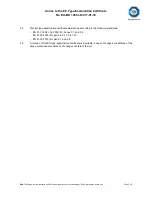
Installation and Operational Instructions for ROBA
®
-diskstop
®
Type 894.5_ _._ _ Size 10
(B.8.4.5.EN)
23/03/2017 TK/TL/GC/SU
Chr. Mayr GmbH + Co. KG
Eichenstraße 1, D-87665 Mauerstetten, Germany
Tel.: +49 8341 804-0, Fax: +49 8341 804-421
Page 3 of 16
www.mayr.com
, E-Mail:
Safety Regulations
These Safety Regulations are user hints only and may not be complete!
General Guidelines
DANGER
Danger of death!
Do not touch voltage-carrying cables and
components.
Brakes may generate further risks, among other things:
Hand injuries
Danger of
seizure
Contact with
hot surfaces
Magnetic
fields
Severe injury to people and damage to objects may result if:
the electromagnetic brake is used incorrectly.
the electromagnetic brake is modified.
the relevant standards for safety and / or installation
conditions are ignored.
During the required risk assessment when designing the
machine or system, the dangers involved must be evaluated and
removed by taking appropriate protective measures.
To prevent injury or damage, only specialist personnel are
allowed to work on the components.
They must be familiar with the dimensioning, transport,
installation, inspection of the brake equipment, initial operation,
maintenance and disposal according to the relevant standards
and regulations.
Before product installation and initial operation,
please read the Installation and Operational
Instructions carefully and observe the Safety
Regulations. Incorrect operation can cause injury
or damage. At the time these Installation and
Operational Instructions go to print, the electromagnetic brakes
accord with the known technical specifications and are
operationally safe at the time of delivery.
Technical data and specifications (Type tags and
documentation) must be followed.
The correct connection voltage must be connected according
to the Type tag and wiring guidelines.
Check electrical components for signs of damage before
putting them into operation. Never bring them into contact
with water or other fluids.
Please observe the EN 60204-1 requirements for electrical
connection when using in machines.
Only carry out installation, maintenance and
repairs in a de-energised, disengaged state
and secure the system against inadvertent
switch-on.
Guidelines for Electromagnetic Compatibility
(EMC)
In accordance with the EMC directives 2014/30/EU, the
individual components produce no emissions. However,
functional components e.g. mains-side energisation of the
brakes with rectifiers, phase demodulators, ROBA
®
-switch
devices or similar controls can produce disturbance which lies
above the allowed limit values. For this reason it is important to
read the Installation and Operational Instructions very carefully
and to keep to the EMC directives.
Application Conditions
The catalogue values are guideline values which
have been determined in test facilities. It may be
necessary to carry out your own tests for the
intended application. When dimensioning the
brakes, please remember that installation
situations, braking torque fluctuations, permitted friction work,
bedding-in condition / conditioning of the brake linings and
wear as well as general ambient conditions can all affect the
given values. These factors should therefore be carefully
assessed, and alignments made accordingly.
Mounting dimensions and connection dimensions must be
adjusted according to the size of the brake at the place of
installation.
Use of the brake in extreme environmental conditions or
outdoors, directly exposed to the weather, is not permitted.
The brakes are designed for a relative duty cycle of 60 %. A
duty cycle > 60 % leads to higher temperatures, which cause
premature ageing of the noise damping and therefore lead to
an increase in switching noises. Furthermore, the switch
function of the release monitoring can be impaired.
The max. permitted switching frequency is 180 1/h.
These values are valid for intermittent periodic duty S3 60 %.
The permitted surface temperature on the mounting surface
must not exceed 80 °C at a max. ambient temperature of
40 °C.
The braking torque is dependent on the current bedding-in
condition of the brake. Bedding in / conditioning of the friction
linings is necessary.
The brakes are only designed for dry running. The torque is
lost if the friction surfaces come into contact with oil, grease,
water or similar substances or any other foreign bodies.
The surfaces of the outer components have been
phosphated manufacturer-side to form a basic corrosion
protection.
CAUTION
The friction linings may rust up and seize up in
corrosive ambient conditions and / or after
longer downtimes.
The user is responsible for taking appropriate
countermeasures.














































